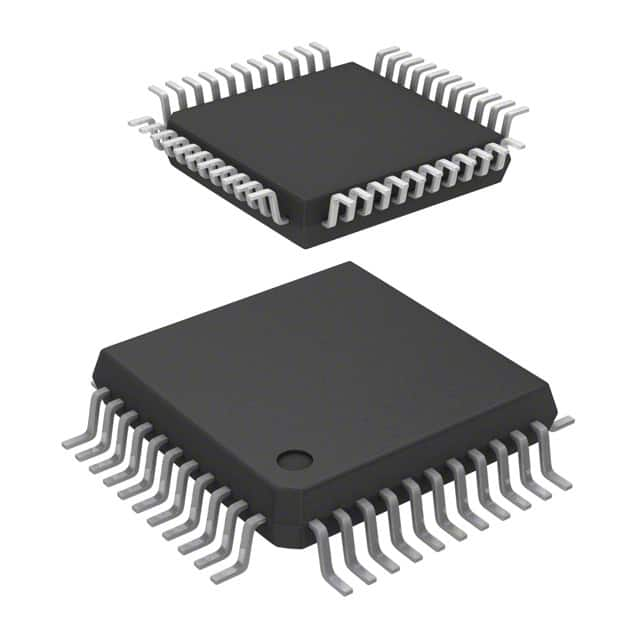ST72C334J2T6
Product Overview
- Category: Microcontroller
- Use: Embedded systems, industrial applications
- Characteristics: High-performance, low-power consumption
- Package: TQFP-44
- Essence: 8-bit microcontroller with Flash memory
- Packaging/Quantity: Tape and reel, 2500 units per reel
Specifications
- Architecture: 8-bit
- CPU Frequency: 8 MHz
- Program Memory Size: 32 KB Flash
- RAM Size: 1 KB
- Operating Voltage Range: 2.7V to 5.5V
- I/O Pins: 34
- Timers: 3
- Communication Interfaces: SPI, UART
- ADC Channels: 8
- Temperature Range: -40°C to +85°C
Detailed Pin Configuration
The ST72C334J2T6 microcontroller has a total of 44 pins. The pin configuration is as follows:
- VDD - Power supply voltage
- VSS - Ground
- PA0 - General-purpose I/O pin
- PA1 - General-purpose I/O pin
- PA2 - General-purpose I/O pin
- PA3 - General-purpose I/O pin
- PA4 - General-purpose I/O pin
- PA5 - General-purpose I/O pin
- PA6 - General-purpose I/O pin
- PA7 - General-purpose I/O pin
- PB0 - General-purpose I/O pin
- PB1 - General-purpose I/O pin
- PB2 - General-purpose I/O pin
- PB3 - General-purpose I/O pin
- PB4 - General-purpose I/O pin
- PB5 - General-purpose I/O pin
- PB6 - General-purpose I/O pin
- PB7 - General-purpose I/O pin
- PC0 - General-purpose I/O pin
- PC1 - General-purpose I/O pin
- PC2 - General-purpose I/O pin
- PC3 - General-purpose I/O pin
- PC4 - General-purpose I/O pin
- PC5 - General-purpose I/O pin
- PC6 - General-purpose I/O pin
- PC7 - General-purpose I/O pin
- PD0 - General-purpose I/O pin
- PD1 - General-purpose I/O pin
- PD2 - General-purpose I/O pin
- PD3 - General-purpose I/O pin
- PD4 - General-purpose I/O pin
- PD5 - General-purpose I/O pin
- PD6 - General-purpose I/O pin
- PD7 - General-purpose I/O pin
- RESET - Reset pin
- XTAL1 - Crystal oscillator input
- XTAL2 - Crystal oscillator output
- VCAP - Capacitor connection for internal voltage regulator
- VPP - Programming voltage supply
- AIN0 - Analog input channel 0
- AIN1 - Analog input channel 1
- AIN2 - Analog input channel 2
- AIN3 - Analog input channel 3
- NC - No connect
Functional Features
- High-performance 8-bit microcontroller with Flash memory
- Low-power consumption for energy-efficient applications
- Wide operating voltage range for flexibility in power supply
- Multiple I/O pins for interfacing with external devices
- Built-in timers for precise timing control
- Communication interfaces (SPI, UART) for data exchange
- Analog-to-digital converter (ADC) for analog signal processing
Advantages and Disadvantages
Advantages: - High-performance and low-power consumption - Ample program memory size for complex applications - Wide operating voltage range allows for versatile power supply options - Multiple I/O pins provide flexibility in interfacing with external devices - Built-in timers and communication interfaces simplify system design
Disadvantages: - Limited RAM size may restrict the complexity of applications - Only 8-bit architecture, which may not be suitable for certain advanced applications requiring higher precision or processing power
Working Principles
The ST72C334J2T6 microcontroller operates based on an 8-bit architecture. It executes instructions stored in its Flash memory to perform various tasks. The CPU frequency of 8 MHz ensures efficient execution of instructions. The microcontroller communicates with external devices through its I/O pins, SPI, and UART interfaces. It can also process analog signals using its built-in ADC. The microcontroller's working principle revolves around executing instructions, managing I/O operations, and interacting with external components.
Detailed Application Field Plans
The ST72C334J2T6 microcontroller finds applications in various fields, including but not limited to:
- Industrial Automation: Control systems
Lista 10 Vanliga frågor och svar relaterade till tillämpningen av ST72C334J2T6 i tekniska lösningar
Sure! Here are 10 common questions and answers related to the application of ST72C334J2T6 in technical solutions:
Q: What is the ST72C334J2T6 microcontroller used for? A: The ST72C334J2T6 microcontroller is commonly used in various technical solutions, such as industrial automation, consumer electronics, automotive systems, and more.
Q: What is the maximum clock frequency supported by the ST72C334J2T6? A: The ST72C334J2T6 microcontroller supports a maximum clock frequency of 8 MHz.
Q: How much flash memory does the ST72C334J2T6 have? A: The ST72C334J2T6 microcontroller has 32 KB of flash memory.
Q: Can I interface the ST72C334J2T6 with external devices? A: Yes, the ST72C334J2T6 microcontroller provides various communication interfaces like UART, SPI, and I2C, allowing you to interface with external devices.
Q: Does the ST72C334J2T6 support analog-to-digital conversion (ADC)? A: Yes, the ST72C334J2T6 microcontroller has an integrated 8-channel 10-bit ADC for analog signal conversion.
Q: What kind of peripherals are available on the ST72C334J2T6? A: The ST72C334J2T6 microcontroller offers features like timers, PWM outputs, GPIO pins, and serial communication interfaces.
Q: Can I program the ST72C334J2T6 using C language? A: Yes, the ST72C334J2T6 microcontroller can be programmed using C language, and there are development tools available to support it.
Q: Is the ST72C334J2T6 suitable for low-power applications? A: Yes, the ST72C334J2T6 microcontroller has power-saving features like multiple low-power modes, making it suitable for low-power applications.
Q: Can I use the ST72C334J2T6 in harsh environments? A: The ST72C334J2T6 microcontroller is designed to operate in a wide temperature range and can withstand certain levels of environmental stress, but it's always recommended to check the datasheet for specific conditions.
Q: Are there any development boards or evaluation kits available for the ST72C334J2T6? A: Yes, STMicroelectronics provides development boards and evaluation kits that include the ST72C334J2T6 microcontroller, allowing you to quickly prototype and test your technical solutions.
Please note that these answers are general and may vary depending on the specific requirements and use cases. It's always recommended to refer to the official documentation and datasheets for accurate information.


